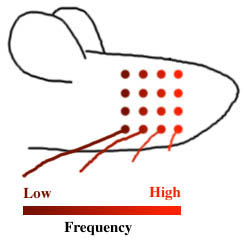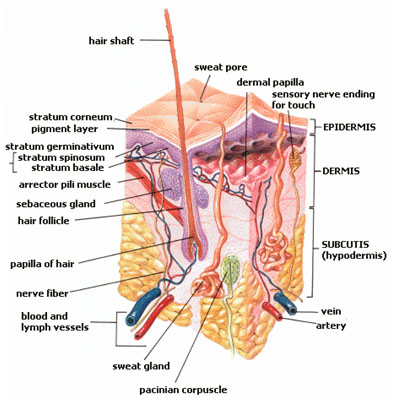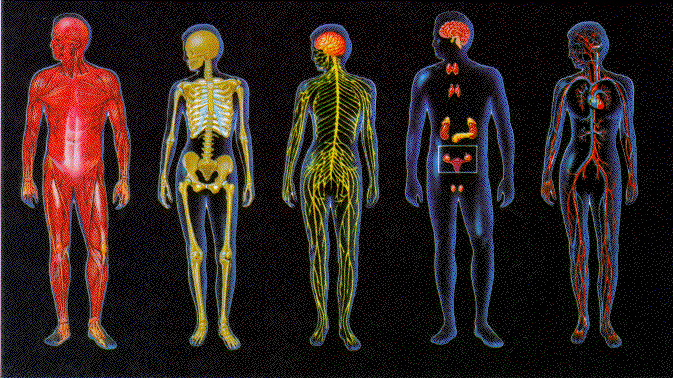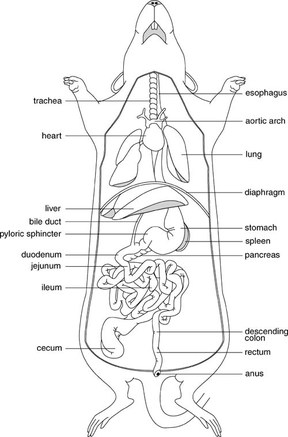Wednesday, January 30, 2013
dorsal fins
I just know found out that the dorsal area is in the mid back thats why on an orka (its an oreka in the pic) its called an dorsal fin when you think about it its realy neat
Saturday, January 26, 2013
Let's talk about skin!
Because we started our forensic examinations by looking at our pigs' skin, I decided to go through some interesting information about our skin:
Next, we examined the skin of the pigs and made notations about it. Some of them had a lot of thick hair, and some had thinner hair. Some had small birthmarks on them.
We determined the gender of each pig, and there were some boys and some girls. We ran out of time before beginning to cut them, so we will make our first incision next week.
- Our skin is our largest organ. The average human being has 21 sq ft of skin and about 300 million skin cells.
- Our skin performs a range of different functions which include physically protecting our bones, muscles and internal organs, protecting our bodies from outside diseases, allowing us to feel and react to heat and cold and using blood to regulate our body heat.
- The layers of mammal skin include the epidermis, dermis and subcutis.
- The outer layer of skin is the epidermis, it is found thickest on the palms of the hands and soles of the feet (around 1.5mm thick). It is thinnest on our eyelids.
- The color of human skin depends on the amount of pigment melanin that the body produces. Small amounts of melanin result in light skin while large amounts result in dark skin.
- The cells in the skin that make melanin are called melanocytes. In general, the ending -cytes or -ocytes means cells, so melanocytes are the melanin-producing cells, and hepatocytes are liver cells because hepato- means liver.
- The melanin in our melanocytes protects us from ultraviolet radiation, and this is why we tan. Darker skin comes from more melanin, so darker skinned people have better protection from sunburn and also from skin cancer.
- However, a trade-off is that vitamin D is produced in the skin after stimulation by sun exposure, and melanin slows this process down a lot. So darker skinned people need to be in the sun more each day to produce enough vitamin D.
- Here is a scientific review article about melanin and how it protects from skin cancer.
- The epidermis is made of keratinocytes, also called squamous cells, which make a protein called keratin. Keratin is a protein in our skin, hair, and nails that makes them strong and tough.
- The very outermost layer of skin is dead and cells flake off all the time. That makes the dust in our houses when enough dead cells accumulate and we can see them. The squamous cells right below that layer are making new cells to replace the ones that fall off.
- The dermis is the middle layer of the skin, and it is the thickest. The dermis contains specialized cells for regulating temperature, fighting infection, storing water, and bring blood and nutrients to the skin.
- Blood vessels bring oxygen and energy to the cells and carry vitamin D to the rest of the body
- Lymph vessels bring immune cells to the skin to fight infections
- Sweat glands release water to cool down the skin when it's hot
- Oil gland, also called sebaceous glands, secret oil to waterproof the skin and protect
- Hair follicles surround hairs and nourish them
- Sensory receptors are nerve endings that send messages to and from the brain
- Collagen is another protein that makes our skin strong and tough
- Elastin is a protein that makes our skin stretchable and rubbery
- The innermost layer of the skin is the hypodermis, also called the subcutis. It includes a lot of fat tissue that insulates the body and it also cushions and protects the internal organs of the body. Fat tissue is also called adipose tissue and extra energy is stored there.
 |
| This is basically what our pigs look like |
Next, we examined the skin of the pigs and made notations about it. Some of them had a lot of thick hair, and some had thinner hair. Some had small birthmarks on them.
We determined the gender of each pig, and there were some boys and some girls. We ran out of time before beginning to cut them, so we will make our first incision next week.
Friday, January 25, 2013
Liver excitement!
I already know a few things about the liver. I want to learn about the pancreas. I have no idea what it is but I'm interested in learning more about it. I'm very excited about the pig dissection.
Things the liver does:- Produces bile
- Breaks down alcohol and some other toxins
- Other cool stuff!
Cool things
We know the symmetry bilateral realy well. I want to learn more about the body system skeletal.
I feel really excited to do the pig. I like the digestive organs.
I like the digestive organs.
I feel really excited to do the pig.
 I like the digestive organs.
I like the digestive organs.
Thursday, January 24, 2013
My Blog Post!
Questions and Answers
I like the brain. because if I didn't have a brain I wouldn't be able to do the complex stuff I do.
Like parkour, snowboard, or BMX bike.
What system do i know a bit about. I'd have to say the nervous system. every time you fall and hurt your self its you brain that tells you that your hurt but your nerves help tell where you hurt your self.
What system I would like to learn more about. I'd have to say the nervous system. It is the one I know the most about but I would like to learn more
Like parkour, snowboard, or BMX bike.
| Pretty colors! |
What system do i know a bit about. I'd have to say the nervous system. every time you fall and hurt your self its you brain that tells you that your hurt but your nerves help tell where you hurt your self.
What system I would like to learn more about. I'd have to say the nervous system. It is the one I know the most about but I would like to learn more
jett's fith blog post
A liver is above. excited to learn about them. i'm realy excited learn about
the immune system. and i'm excited about starting the dissection of the pig.
Intestines Alive!
 |
| Not complicated enough? |
I like the intestine because they have lots of interesting facts about them like the length if you unravel them. I would like to learn more about the liver and pancreas. I think the pig will be the biggest deal of the all the animals because it is the largest and it is a mammal. Think about how little the frog was and how intersting it was. The pig is going to be even more interesting because it is larger and you aren't poking your fingers around in a microscopic animal.
Anne Sophie
sliiiiiiiiiiiiides
The slides: we saw lung and liver tissue. The lung and liver tissue looked like tomatoes with holes in them. The lung had some minor blood vessels. I can't wait to dissect the pig.
Anne Sophie
Wednesday, January 23, 2013
Kidney
I know about the kidney that it cleans your blood. I want to learn more about everything especially the brain. I feel OK about the pig dissection.
The amazing Heart...
I don't really know very many body systems in depth since this is my first class that discusses different body systems.
I think I would like to learn about the nervous system and learned how we are able to control our bodie's.
I feel really excited about dissecting the pig!
You guys have to subscribe to this channel, they are so funny!!!
Subscribe to this Channel
I think I would like to learn about the nervous system and learned how we are able to control our bodie's.
I feel really excited about dissecting the pig!
You guys have to subscribe to this channel, they are so funny!!!
Subscribe to this Channel
Monday, January 21, 2013
Review of Fall Semester -- Pigs have arrived!
In class this week, we reviewed what we learned from all the dissections of the fall semester. Some of the concepts we had covered were: symmetry, cephalization, completeness of the digestive system, jointed appendages, and vertebrae.

- Symmetry meant whether there was a pattern to a body in which two sides are mirror images (bilateral) or you could rotate the body and find a position that lined up (radial).
- Cephalization was whether there was a brain, a group of nerve cells called a ganglion, or no brain-like structure.
- The digestive systems were complete if the animal's food went in one end and came out the other, and incomplete if the waste came out the same opening the food went in.
- Jointed appendages are limbs like arms or legs that have joints.
- Vertebrae are bones that line the nerve cord or spinal cord.
 |
| What vertebrate group did we look at that isn't on this chart? |
We made a chart about the animals we dissected and these five concepts:
It was really neat to see how much we've learned, and how many animals we've already studied! We also reviewed the five kingdoms: Monera (bacteria), Fungi, Plantae (plants), Protista, and Animalia (animals). The kingdoms are subcategorized into phyla (singular is phylum). Here is the phylum for each animal we studied in the fall:
- sponge: Porifera
- hydra: Cnidaria
- planaria: Platyhelminthes
- mussel: Mollusca
- earthworm: Annelida
- crayfish: Arthropoda -- class is Crustacea
- grasshopper: Arthropod -- class is Hexapoda (insects)
- sea star: Echinodermata
- amphioxus: Chordata, though we discussed that Hemi-chordata would make more sense
- perch: Chordata
- frog: Chordata -- class is Amphibia
- snake: Chordata -- class is Reptilia
- rat: Chordata -- class is Mammalia
The scientific naming system uses two words to describe each organism, the genus and the species. One species of perch is Perca flavescens, one species of frog I am familiar with is Xenopus laevis, lab rats are Rattus norvegicus, my least favorite housemate is the fruit fly, Drosophila melanogaster, and we people are Homo sapiens.
Here is an example of the classification system showing how it gets more specific with each level until you only have one organism.
Now, we are going to move on to the pig dissections, which will be in in-depth look at the body systems mammals have, as well as an exploration of autopsies and forensics. We discussed that autopsies have one of two purposes: both are to find out why someone died, but clinical is for medical reasons -- like whether it was a heart attack, seizure, or aneurysm -- and forensic is to gather evidence about a crime -- generally the murder of the person in question. In zoos and in laboratories, if an animal dies, a necropsy is the term for the investigation to determine why the animal died.
We will be dissecting our pigs in the style of an autopsy, including sewing the animal up at the end, which is done in human autopsies to leave the body ready for burial. Along the way, we will look at the following systems: muscular system, nervous system, cardiovascular/circulatory system, respiratory system, digestive and excretory system, endocrine system, and reproductive system. We have two adult pig organs to compare with our fetal pigs: a heart and a kidney. They are surprisingly large!
 |
| artery |
I got a new dissecting scope that has a camera we can connect to the computer and project onto the big tv screen, and the kit we got included a few stained slides to look at. So, we explored the new scope a bit and took a few interesting pictures. These pictures are of an artery, a vein, and a hair from Henry's head.
 |
| Henry's hair |
 |
| vein |
Friday, January 11, 2013
Rats! And Rats Again!
The holiday break is over and we're dissecting again! We dissected rats a second time and looked more at the muscles and bones this time. To catch up with the blog, here's what we covered on the rats before break:
 So we could see that people are very interested in researching ourselves! I discussed two articles about rats: one was about their whiskers, because people are interested in understanding how rats get information from their whiskers. There is an interesting area in the brain called the barrel cortex, and it is where information from each whisker goes to a special spot.
So we could see that people are very interested in researching ourselves! I discussed two articles about rats: one was about their whiskers, because people are interested in understanding how rats get information from their whiskers. There is an interesting area in the brain called the barrel cortex, and it is where information from each whisker goes to a special spot.
 The other article I discussed was about stomach damage that occurs when the liver is diseased. When someone has liver damage called cirrhosis (which can be caused by alcoholism), their stomach can be more sensitive and easily damaged. In this research study, some rats were given liver damage and some were not. Both groups were then tested to see how easily their stomachs were injured, and some received treatment drugs the researchers were testing. They found that one drug, called ET-3, seemed to protect the rats from stomach injury, which helped the researchers understand more about how the stomach injury may be happening.
The other article I discussed was about stomach damage that occurs when the liver is diseased. When someone has liver damage called cirrhosis (which can be caused by alcoholism), their stomach can be more sensitive and easily damaged. In this research study, some rats were given liver damage and some were not. Both groups were then tested to see how easily their stomachs were injured, and some received treatment drugs the researchers were testing. They found that one drug, called ET-3, seemed to protect the rats from stomach injury, which helped the researchers understand more about how the stomach injury may be happening.
- Rats are in the phylum Chordata and class Mammalia (both in the kingdom Animalia)
- Mammals have hair (or fur), have mammary glands to produce milk, and bear live young
- Looking externally, we saw that they have whiskers next to their noses, have long teeth in their mouths, have a nictitating membrane over their eyes to keep in moisture, have external ear parts called the pinna, have visible mammary glands, and all of ours were females
- Mammalian hearts have four chambers
- The diaphragm is a thin membrane of muscle separating the heart and lungs from the lower abdominal cavity
This week, we started by talking about research articles. In trying to decide what article to discuss, I knew there would be quite a lot of choices, since rats are a major research animal, and many studies on them are published all the time. So, I decided to make a list of how many articles were published in 2012 on each of several species or groups of species. Here's what I found by searching PubMed:
Number of articles pubished or accepted for publication in 2012 on
- Rats: 185,624
- Mice: 205,424
- Zebrafish: 4,510
- Drosophila melanogaster (fruit flies): 11,949
- Corn: 5,523
- Bacteria (in general): 180,158
- Viruses: 91,308
- Human: 1,242,225
 So we could see that people are very interested in researching ourselves! I discussed two articles about rats: one was about their whiskers, because people are interested in understanding how rats get information from their whiskers. There is an interesting area in the brain called the barrel cortex, and it is where information from each whisker goes to a special spot.
So we could see that people are very interested in researching ourselves! I discussed two articles about rats: one was about their whiskers, because people are interested in understanding how rats get information from their whiskers. There is an interesting area in the brain called the barrel cortex, and it is where information from each whisker goes to a special spot.
Next, we dissected the rats, and talked about several important things:
- There are two main body cavities: the thoracic and the abdominal
- In the thoracic cavity are the heart, lungs, trachea, esophagus, and ribs.
- The trachea is the rigid tube that goes from the mouth down to the lungs. It needs to stay open so we can breathe, and it branches into two bronchi.
- The esophagus is the soft tube that goes from the mouth down to the stomach.
- In the abdominal cavity are the stomach, liver, gall bladder, intestines, kidneys, bladder, pancreas, and spleen
- The diaphragm separates the two, but also is what allows us to breathe. When it moves down, we breathe in, and when it moves up, we breathe out. It is also responsible for the hiccups!
- The largest internal organ is the liver, and it has four lobes.
- The liver produces bile, which helps digest food. It is also why our poop is brown!
- The largest external organ is our skin!
- Some muscles that rats and humans have are the biceps, triceps, deltoids, obliques, quadriceps, latissimus dorsi, and abdominals
- Some bones we talked about were the femur, tibia, fibula, and the hip ball-and-socket joint
- The kidneys filter our blood, and if you have no working kidneys, you have to have dialysis to clean your blood. But one working kidney is enough, so you can donate one to someone else to save their life!
Subscribe to:
Posts (Atom)












